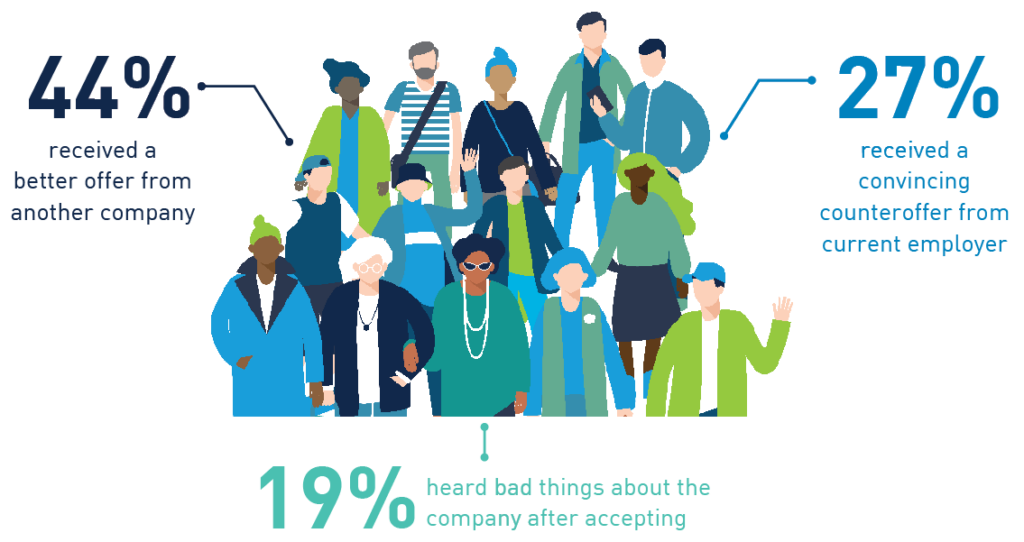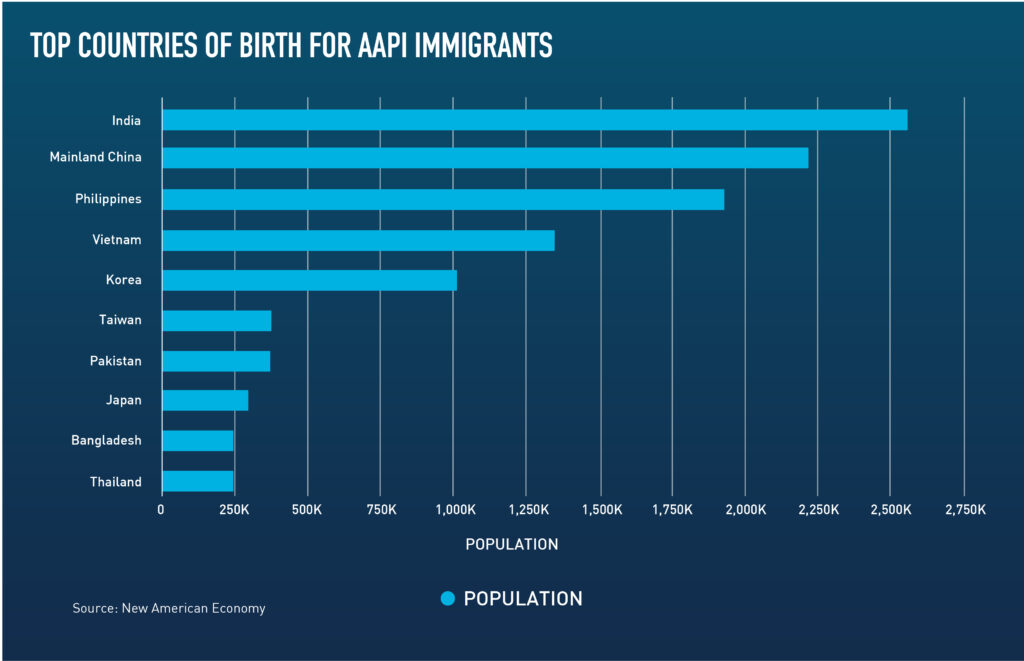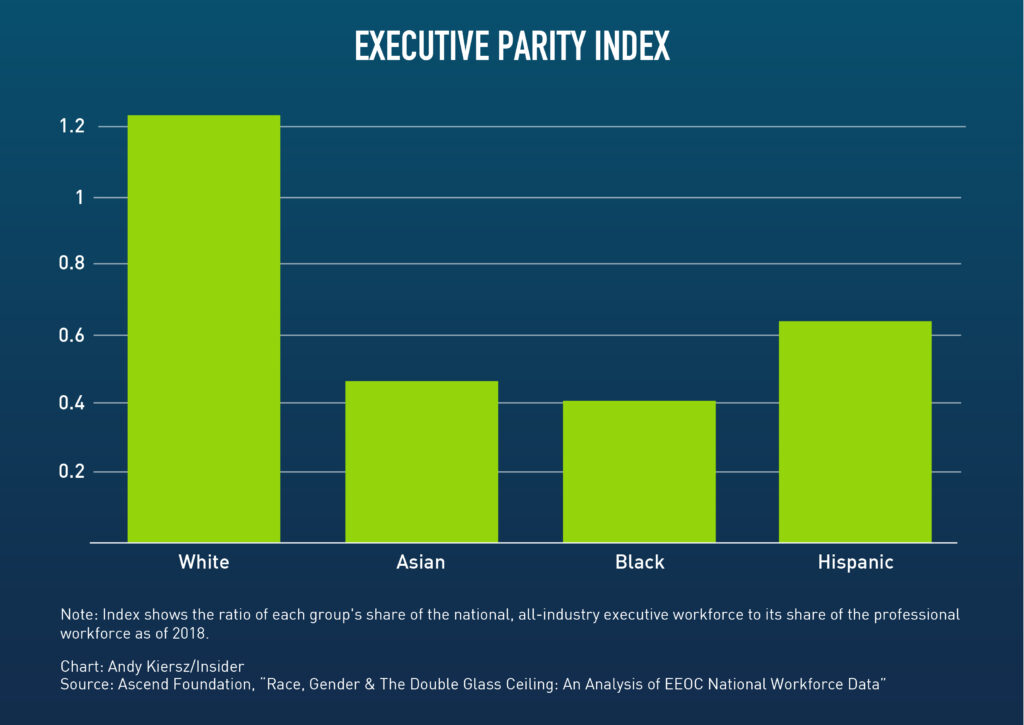Recruitment marketing is now an essential strategy as the talent acquisition landscape is more competitive today than it has been at any point in history. Specifically, the global talent shortage stands at 40 million workers and is forecasted to reach more than 85 million by 2030, costing employers around the world more than $8 trillion in lost revenue. This means that, to stay ahead, employers need to implement new strategies and reimagine what talent acquisition can be; talent leaders need to be able to draw in candidates in the same way that brands draw in consumers.
To make that process even more difficult, the types of offerings that job-seekers want from a potential employer has shifted dramatically in the past few years: According to LinkedIn’s Global Talent Trends Report, since 2019, there’s been sharp growth in members posting about the following topics:

The data is clear: Candidates are seeking employers that can provide flexibility and a greater work/life balance. As a result, organizations that excel at highlighting a company culture that’s compatible with current talent market trends will remain competitive in the hunt for talent.
As a talent professional, you may not think about marketing as a recruitment function. However, a large part of ensuring that your talent pipeline is stocked with the best talent involves making sure that your organization is an attractive place to work for candidates. Thus, recruitment and marketing need to work together. The job of a talent acquisition team is more than just hiring great talent; it also includes attracting talent and enticing them to commit. In this four-part section, we’ll cover how employers can leverage modern marketing techniques to recruit and better engage candidates at each stage of the recruitment marketing funnel.
Recruitment Marketing and Hiring Strategies Part One: The Case for Implementing Modern Digital Marketing Strategies
Typically, consumers require engagement across multiple touchpoints before deciding on a purchase—and it’s up to an organization’s marketing team to facilitate engagement at each stage of the sales funnel. Job-seekers are no different and often need multiple interactions with an organization’s employer brand before applying for a role; in this case, it’s the job of the talent acquisition team to facilitate these interactions throughout the recruitment funnel.
Granted, the stages of the talent acquisition funnel depend on an organization’s hiring practices, but we can make some generalizations. For the purposes of this article, we’ll cover three vital functions in the recruitment marketing process: 1) attracting active and passive candidates, 2) converting candidates and 3) closing candidates. During each of these functions, talent teams need to properly engage and nurture job-seekers with the right recruitment marketing strategies. Below, we outline smart recruitment marketing strategies for sourcing passive candidate and active candidate engagement.
Talent Attraction: Sourcing Passive Candidates
According to LinkedIn, 70% of the global workforce are passive candidates, with the remaining 30% of talent actively seeking jobs. With that in mind, the first—and arguably most important—function in recruitment marketing for talent acquisition teams is to determine a strategy to attract candidates. Of course, candidates may already have some idea of your organization as a consumer brand, so the main objective of this stage is to introduce your organization’s employer brand to job-seekers for the first time to improve recruiting passive candidates.
At this stage, your engagement with candidates should be designed to gain and retain their interests, with the hope of converting them later in the recruitment marketing funnel. As such, building employer brand awareness and providing positive candidate experiences is key. For instance, consider how candidates will perceive your organization through the channels listed below. Will they have a positive view of what it’s like to work for your organization? Do they get an accurate picture of your company culture?

Converting Passive Candidates
The main marketing priority for talent acquisition teams during the passive candidate conversion stage should be to steer candidate interest into action, thereby converting them from job-seekers into active prospects in the talent pipeline. This step occurs when candidates gain a positive impression from the touchpoints they encounter in the attraction stage.
Fortunately, there are various methods for converting candidates. For example, they can sign up for a newsletter, register for an event or request job posting updates via your career page. And, while they may not have applied to any of your open positions yet, they’re interested enough in your organization to provide their contact information. Similarly, employers can also leverage talent communities to convert candidates looking to connect with other professionals in their industry. Remember, to comply with the General Data Protection Regulation (GDPR), just make sure to collect two types of consent when collecting personal data (such as email, phone, address, name, etc.) from applicants.
Additionally, at this stage, keep in mind that you’re asking candidates to provide your organization with two of their valuable resources: Time and personal information. Next, at the conversion stage, you’re asking for contact information, but only a small amount of time. Then, to get to the next stage, candidates will have to give your organization even more of both. Therefore, in the touchpoints listed below, consider what the experience is like for candidates; is it positive and easy enough to get someone to a closing stage?

Closing Candidates
During the closing function in recruitment marketing, talent teams are managing a flow of vetted and engaged candidates with a goal to turn these candidates into applicants. This means that candidates are willing to take the time to complete your application and provide you with a significant amount of personal information. Notably, the candidate is also making an emotional investment in your organization; they’re excited for this role. As such, they could be setting themselves up for disappointment if they don’t make it through the process. For this reason, it’s important to consider what you’re asking of candidates to help get them through the closing process.
Furthermore, while closing prospects, your recruitment marketing materials should aid the candidate’s decision-making process by informing them of open positions, inviting them to recruiting events, or even proposing a virtual meet-and-greet where the candidate can casually meet with members of your team. Think about the touchpoints listed below and how candidates will experience them. Likewise, communicate about your interviewing and hiring process upfront for a more seamless experience for both candidates and hiring managers.

Closing Candidates
In parts two and three, we’ll go into greater detail on how talent acquisition teams can leverage modern marketing techniques to intelligently engage candidates at each stage of the recruitment marketing funnel.
Recruitment Marketing and Hiring Strategies Part Two: Creating Talent Acquisition Content That Engages Candidates
Content marketing has fast become a go-to channel for marketing teams looking to generate interest in products; gain leads; drive organic traffic; and build a library of informative and in-depth content for clients and prospects.
However, attracting both active and passive candidates with content isn’t limited to just marketing to potential customers; rather, recruitment departments can also harness the power of well-crafted content to convert job-seekers into applicants. In fact, content marketing can help talent teams engage top candidates in a number of thoughtful and meaningful ways that intersect with a job-seeker’s interests.
Effective content for recruitment marketing can also make a difference in moving the candidate along to the next stage. In particular, content marketing as a talent acquisition strategy should focus on engaging job-seekers with relevant articles, white papers relevant to their career interests, webinars, videos, or podcasts to help a candidate navigate through an employer’s recruitment funnel. When brainstorming recruitment content, look at industry publications and professional groups on LinkedIn to identify current topics of interest for candidates in your industry.
In Part Two of this section, we’ll discuss how to create relevant content and ensure candidates are able to find it.
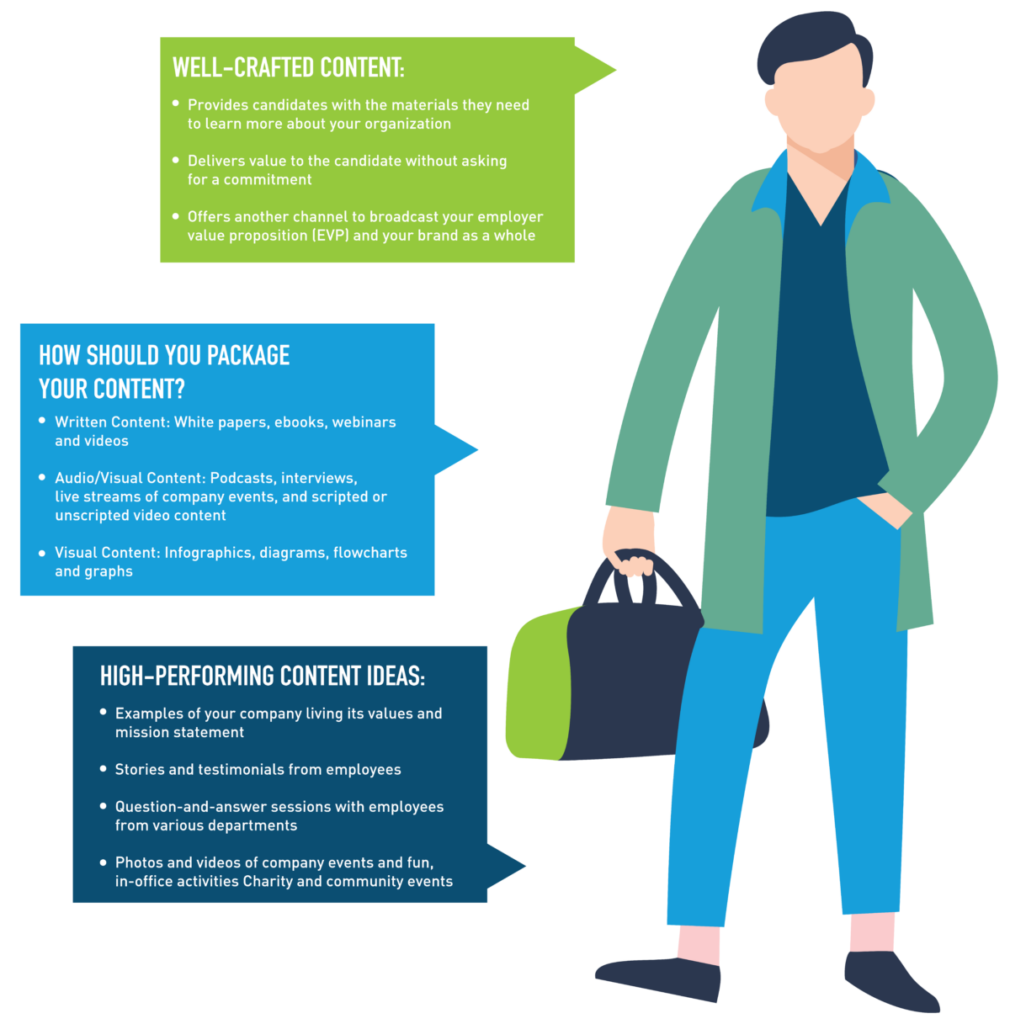
Recruitment Digital Marketing: Considering Different Types of Talent Acquisition Content
An effective content marketing strategy includes a variety of content types to fill various channels and appeal to different types of candidates. That’s because some candidates may prefer to watch a video, whereas others would rather read an article. Likewise, some may like to learn in bite-sized pieces, while other appreciate an in-depth article. With that in mind, below are a few types of content to consider adding to your mix.
Recruitment Marketing Ideas: Leverage Your Career Blog
Your organization may already have a blog where the marketing team regularly posts content for your potential customers. In the same vein, consider a blog on your careers site to better educate and engage candidates about what it’s like to work for your organization.
Then, when generating blog articles, keep in mind that each piece of content needs to be of value to the reader. According to the Content Marketing Institute, only 66% of marketers prioritize their audience’s needs over their sales message when creating content. In contrast, 88% of the most successful marketers prioritize audience needs over sales messaging.
To that end, consider:
- Interviewing employees across all roles and asking them to describe how they got to where they are today
- Sharing news about exciting projects
- Featuring hiring managers to discuss the hiring process and post updates on upcoming events
Similarly, if you have strong writers on your team, ask them to write short blogs about their experiences.
Video Content
Video is a great format for recruitment content that often boosts candidate engagement. Take the booming popularity of video-based social media platforms like TikTok, YouTube and Instagram as evidence that this is a particularly influential type of content for young workers. Video is particularly powerful on social channels, so consider amplifying your efforts by encouraging colleagues to act as employee brand ambassadors for your organization on their social channels. Besides, job-seekers trust an organization’s employees three times more than the company itself to provide credible information on what it’s like to work there.
If you’re just getting started in video, don’t worry about high production quality. Due to the popularity of tools like Zoom during the pandemic, as well as the proliferation of video on social media, candidates are used to watching basic videos. In fact, the authentic feel of these types of videos can often yield even higher engagement than professionally produced content.
Micro & Social Media Recruitment Content
Talent teams are stretched thin, so consistently creating long-form content may be challenging. So, if your team lacks the bandwidth to create long-form content, consider shorter, “micro content.” This might include sharing small bits of entertaining or informative news or industry updates with candidates on social media or micro-content platforms.
Social media, in particular, is perfect for micro content, with 94% of content marketers using social media platforms to distribute content. This content could include fun moments from the workplace, employee testimonials, or short videos of the company participating at a career fair or a conference. Essentially, content marketing is an opportunity to explore as many different ways to connect with your audience as possible; just remember to stay on brand and keep a consistent theme with language and design. This way, prospects will enjoy a more uniform and cohesive candidate experience.
SEO & Recruitment Marketing: Leveraging Search to Source Talent

If you take the time to create content for candidates, it’s important to make sure that they can find it easily. Search Engine Optimization (SEO) is the practice of optimizing a website to rank higher in search engines like Google, Yahoo and Bing—and doing so can help drive job-seekers to your careers page organically. In particular, well-optimized pages rely on homing in on and deploying the right set of keywords, as well as tailoring metadata for search and making sure the pages load quickly.
When done right—and in conjunction with high-quality content—SEO can lead to a great deal of traffic and conversions on a career site. Plus, leveraging SEO as a talent acquisition strategy makes sense, as 70% of job searches begin on Google. What’s more, 51% of all content consumption comes from organic traffic. Accordingly, with employers across the globe struggling not only to source and recruit talent, but also to increase retention, a smart SEO strategy is an integral component in the recruitment marketing arsenal.
Metadata
Meta titles and meta descriptions are the two fields that show up on a Search Engine Results Page (SERP). This is the page you see after typing something into a search engine like Google. Metadata makes it easier for Google to spot and index your careers page content on relevant search results pages. For this reason, your meta title should be clear so job-seekers immediately know the title and location of the job opening when they visit your page. The meta description is the caption beneath the title that describes the web page’s content in more detail. A tailored meta description helps Google and job-seekers quickly identify and interact with your content in the way that you intend.
When creating a meta description, try to stick to the following guidelines:
- Limit it to no more than 155 characters.
- Keep it clear and concise, with a call to action for job-seekers.
- Reference the language of the page you’re working on to really nail your metadata.
Keyword Research
Although it can be time-consuming, researching and choosing the right keywords can also help you obtain greater visibility from qualified job-seekers, as well as increase organic search traffic to your site.
Begin by understanding which short- and long-tail keywords job-seekers use to search for jobs relevant to your company. You can also research which keywords your competitors are using in their job postings, as well as more comprehensive content, to inform and expand your keyword list. Notably, this may require job titles and descriptions to be altered. While you’re at it, pay close attention to keyword intent—the reason for a job-seeker’s search. Ensuring that this is part of your SEO recruitment strategy guarantees that keywords are aligned to your broader business goals. Additionally, if you’re a brick-and-mortar business, utilize locally focused keywords in your content to better reach quality candidates in close proximity to you.
Content marketing can also fuel other parts of the recruitment marketing mix, and email is the perfect channel to start expanding your content marketing program. What’s more, content and email marketing campaigns can complement each other by increasing the sharing of content and expanding reach. In the next section, we’ll offer tips on how email marketing can give your content a boost.
Recruitment Marketing and Hiring Strategies Part Three: Email Marketing & Talent Acquisition
Email marketing has been around for decades as an effective means of prospect engagement. However, that doesn’t mean that you can just throw together an email, send it out and expect great results. Nowadays, prospects are savvy about techniques deployed by marketers and may become annoyed or tune out marketing messaging that’s done incorrectly.
However, when recruitment marketing email campaigns are successful, recruiters can engage candidates at the right cadence. According to a DataBox survey, 33.3% of marketers said they sent weekly emails, while 26.7% sent monthly emails. In this case, recruiters can leverage the expertise of their marketing teams regarding send times, email schedules and other data points to ensure that content is optimally delivered. Plus, well-cadenced and timely emails ensure that your employer brand is in front of prospects at the right time, making your employer brand more memorable to prospects looking to shift careers.
Furthermore, email recruitment marketing can be an effective strategy for distributing your marketing content to candidates, as well as building additional trust in your employer brand. Notably, 77% of consumers preferred email marketing over other methods of permission-based advertising. And, email marketing often produces results because the audience has opted in to receive marketing materials and wants to hear from you. (Plus, they can choose to opt out at any time.)
So, in this article, we’ll cover the different types of emails that you can use to interact with candidates; how you can use your content marketing collateral to boost the influence of your emails; and how to craft effective messages.
Types of Recruitment Marketing Emails
Email Newsletters
Marketing teams often send email newsletters to prospective and current clients to update recipients on company news, content, products, and other company updates. Similarly, talent acquisition teams should also consider creating newsletters to keep candidates warm.
Specifically, your newsletter could share thought leadership pieces from your organization, webinars, job events and more. You can also use email newsletters to share the content marketing pieces you’ve created for your careers site. Or, link to articles on your careers blog or a video interview you’ve posted with a current employee. Periodical newsletters and other helpful content will also keep your employer brand top of mind and increase the likelihood of your talent community recommending you to a member of their network.
Job Application Invitation Email
The first time many candidates hear from an organization is when a recruiter or sourcer reaches out inviting them to apply for a specific role. These types of emails are common, and your recruiters likely already send them frequently. However, they can be made more effective.
For example, the goal of your email copy should be to gain a prospective candidate’s attention in the first sentence. Therefore, crafting an engaging, but brief introductory sentence or two helps the reader understand who you are and why you’re reaching out.
Typical recruitment emails often begin with an introduction of the recruiter, such as: “Hi, I’m a recruiter with {employer}. We have an open position you may be interested in.”
Instead, consider opening with: “Hi {Name of Candidate}, My name is {Your Name} and I noticed that your experience in X could make you a great fit for Y role at Z company. Would you be interested in setting up a time to discuss Y role and Z company?”

In the first approach, notice how the company puts itself ahead of the candidate. Alternatively, in a more personalized approach, the employer places the prospect at the heart of every communication.
Interview Invitation Email
If a candidate makes it further along in the recruitment funnel, you’ll likely send them an email inviting them to interview. And, when inviting a candidate to interview, it’s crucial that the following are included in your recruitment email:
- Where the interview will be
- The agenda of the interview
- Who will be involved in the interview
Providing all of this information upfront will help everyone be better prepared, more productive and better focused on what matters during the interview. Below, we’ve outlined how to structure your interview invitation email:
- 1st paragraph: Quickly explain who you are and why you’re emailing the candidate so they know they’re being invited to interview, not apply.
- 2nd paragraph: Here, provide a date that’s best for your team or give a few options for the candidate to choose from.
- Third paragraph: Offer a clear agenda to keep the candidate on track. This will also give the candidate a better idea of what to expect and help them prepare.
- Fourth paragraph: Provide the location of where your interview will take place, including how to get there and who to ask for when they arrive. Or, if the interview will not be in-person, share instructions on how to interview virtually.
Offer Emails
Top candidates are often sent offers quickly after interviewing, so it’s important to reach out fast. The moment your talent acquisition team is ready to make an offer, be sure to include the following in your offer email.
First paragraph: Include a brief greeting and review of the interview you had with them.
Second paragraph: Get right to the point and congratulate them on the offer. Double-check everything and make sure that you’re presenting the offer in the best way possible in terms of candidate expectation, salary, benefits and work location. Many times, this information is the deciding factor as to whether the candidate accepts the offer.
Call to action: Remind the candidate that they need to take action, outlining when and how to take it. Also, include contact information in case the candidate has questions about the offer. Finally, to end this email with a persuasive punch, include a line about the candidate’s future with your organization.
Best Practices for Crafting Recruitment Emails
Subject Lines
Subject lines are arguably the most important component of an email as 64% of email recipients decide to open emails based on subject lines. Therefore, while much of your focus may be on creating the copy and imagery of your email, you should also take time to write a great subject line.
More precisely, a great subject line is short, descriptive and provides a call to action (CTA). Unfortunately, many recruiting emails are written without mobile users in mind. But, with 41% of emails opened on mobile devices, it’s crucial to keep your writing concise because most mobile devices are only capable of displaying five or six words of a subject line. Also, consider a little personalization in your subject lines. Personalized subject lines in email increase unique open rates by up to 27%, leading to an 11% higher click-to-open rate overall. Consider this option:

In this example, the sender has personalized the email by referencing a career milestone, while simultaneously inviting the recipient to have a low-pressure conversation. This approach appeals to the candidate’s experience and offers the promise of a career opportunity where future growth is possible.
Body Copy
While you may be tempted to share a lot of information in your cold recruiting emails, recipients might not have time for all of it. Conversely, a study by Boomerang found that emails with 75 to 100 words had the highest response rate; so, write short, descriptive and action-driven copy and provide only the essential information that’s relevant to your candidates. Additionally, avoid buzzwords or jargon so that your offer clearly stands out.
The labor market will likely remain highly competitive for the foreseeable future, with employers battling it out for candidates’ attention. And now, more than ever, candidates understand what they want from work and are trying to find an environment where they’ll belong and grow. So, to attract talent, it’s essential to show candidates that you’re offering more than just a job—and that begins with recruitment marketing that showcases the value you provide to candidates.
Remember, the goal of talent acquisition marketing is no longer to just post a job offer and wait for applicants; it’s about fostering a community, enriching its members, and helping to nurture and encourage them to consider a career with your organization.
Part 4: Recruitment Marketing Strategy in Action: Bridging the Gap Between Consumer & Employer Brand for Vodafone
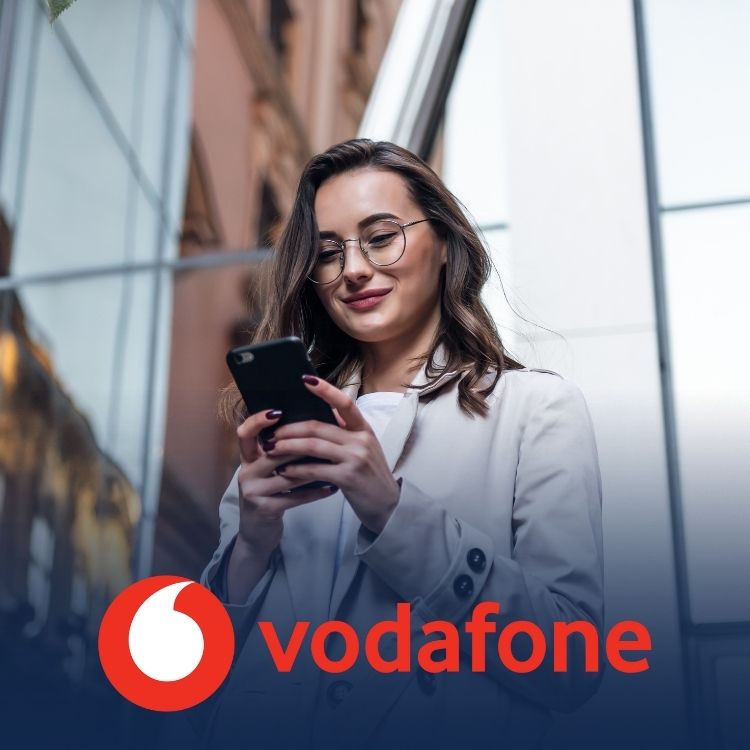
A well-managed and reputable employer brand can go a long way in helping organizations recruit better talent, improve hiring metrics and position an organization as an employer of choice in their industry. In fact, according to Glassdoor, 92% of candidates would consider changing employers if they were offered a role within an organization that had a good reputation. As a result, a strong brand can improve cost per hire by up to 50%.
Moreover, Glassdoor found that the benefits of a powerful employer brand extended beyond recruitment; consider that nearly 30% of candidates have resigned within the first 90 days of starting a role, citing misalignment between the employer and their employer brand. Conversely, organizations that actively invest in employer brand improve their turnover by as much as 28%.
At PeopleScout, we pride ourselves on our ability to partner with clients to hire top talent by building a strategic talent acquisition architecture with employer branding at its heart. So, in this article, we present a real-world example of how PeopleScout’s expert team of talent advisors provided employer branding guidance and delivered a recruitment marketing strategy for the campaign that attracted, engaged and hired the best talent for multinational technology conglomerate Vodafone.
Changing Minds
When an organization’s brand is a household name, there’s often an overlap in sentiment between consumer and employer brand in the minds of the public—an association that can sometimes come with unforeseen complications. This was the case for PeopleScout client Vodafone. Its reputation among the UK public was one of a mobile phone retailer and nothing else—a perception that hurt the organization’s ability to become an employer of choice among young people.
However, behind that perception, Vodafone is a multifaceted innovator in the technology and communications industry with a mission and purpose to make the future a better place. With this knowledge, it was up to PeopleScout’s team to reshape Vodafone’s employer brand in the minds of its target demographic: Newly graduated job-seekers who shared the company’s passion for improving communities and the lives of their customers.
Hiring with Purpose
In employer branding, purpose is the key to unlocking the way that an employer engages with job-seekers. Now, more than ever, job-seekers want more from their employer; they want to feel a sense of belonging and that the work they do has meaning and provides a sense of personal development. In fact, according to research from Blue Beyond Consulting of knowledge workers aged 45 and younger, 52% said they would quit their jobs if their employers’ values didn’t align with their own.
Notably, Vodafone’s future hiring strategy was focused as much on purpose as it was on placing great talent in the right roles. Its purpose was to address high levels of youth unemployment head on by committing to hire up to 100,000 young job-seekers with digital workplace experience. Then, Vodafone set another ambitious goal: To support the development of digital skills in 10 million young people, given that one in five candidates in their target demographic stated that they felt underprepared for the digital economy.
To help Vodafone meet its bold vision of the future, PeopleScout needed to craft an employer brand with multigenerational appeal to attract candidates from Millennials to Gen Z and beyond. Ideally, these candidates are achievers with ambitions beyond working in mobile phone retail. As such, Vodafone’s employer brand campaign had to engage imaginations and change its audiences’ perceptions by presenting itself as a major tech company—not a retailer—and by building its reputation as a youth employer of choice for ambitious job-seekers.
Audience Insights: Leveraging Social Media to Reach the Right Audience
Social media platforms are one of the most broadly used channels for employers looking to build and improve their employer brands. Of course, this isn’t surprising when your factor in the following: 25% of all job-seekers use social media as their primary tool for job-searching and seven out of 10 18- to 34-year-olds report having found their previous job through social media. The case for social media recruiting is clear, but how can employers effectively integrate social media strategy into their employer brand?
For Vodafone, we found that 90.4% of the brand’s target audience regularly used social media. On top of this, 91% of all social media users accessed channels via their mobile devices. With this in mind, we developed a mobile-first, social media-friendly campaign. Additionally, further research showed us that many students with the right background and personal qualifications didn’t apply due to a lack of confidence. Therefore, we needed a message that was bold, relatable and empowering.
Meanwhile, just as important as the audience insights were the strategic considerations. Candidates are also customers; when buying products, they expect a streamlined, user-friendly, friction-free process. And now, they have the same expectation when making career decisions. So, we made every touchpoint (especially applying) as slick and easy as possible.
Granted, no contemporary attraction approach can be just about advertising; long-term connections are far more powerful. So, central to our strategy was helping Vodafone engage in conversations, initiatives and support with high-potential university students throughout their full university lifecycle. In short, the strategy was to start on day one, not year three.
The Core Message: #GENERATIONPOSSIBLE
There are a variety of strategies you can employ to share your employer brand with candidates, but storytelling is one of the most powerful. From career sites to job-search platforms, there are plenty of opportunities to tell interesting, unique stories that capture the attention of job-seekers and entice them to apply. But, knowing exactly what stories to tell—and how to tell them—is not always easy.
So, our message for Vodafone’s campaign aimed to capture the spirit of change and possibility, as well as draw on the opportunity for young people to have an influence on the world for the better. For instance, the visual elements of the campaign approach used photography that reflected our target audience, combined with bold headline statements. Similarly, social and site content featured current grads and interns sharing their advice for the next generation of Vodafone employees.
Campaign Highlights:
- A six-month social media strategy targeted to mobile users
- A #GenerationPossible video at the heart of the campaign
- A campaign matrix of 104 social posts with 20 mini videos/GIFs
Supporting Executions
Our research identified that our target audience felt like they weren’t good enough or lacked the skills to take on these roles. So, we created a series of videos featuring current Vodafone graduate recruits and interns. These videos explored Vodafone life, wellbeing, social responsibility, innovation, assessment center and other advice to help prepare candidates for the interview process.
Hiring Strategies: Spreading the Employer Brand Message
Apart from social media, we also organized a series of 41 on-campus events to connect students directly with Vodafone employees. We also carefully targeted campuses with the highest female-to-male ratios for tech degrees as a way to help increase female applications.
Results
The campaign comfortably exceeded Vodafone’s expectations:
- Vodafone generated more than 16,000 applications, performing 60% above its targets.
- PeopleScout’s campaign helped improve diversity, increasing female applicants by 23%.
- We increased Instagram post impressions by 89.3% (post-campaign vs. pre-campaign).
- Social media drove strong engagement and provided more than 1.5 million Facebook impressions, as well as 6.8 million impressions on organic posts on LinkedIn.
- PeopleScout also deployed a hyper-targeted paid Facebook campaign that produced 390,510 impressions and 2,541 clicks—all from the audience we wanted to target.
These numbers are backed up by audience sentiment: We significantly improved Vodafone’s reputation as an employer, jumping 27 places in the TT100 rankings. As a result of this success, Vodafone also asked us to develop the concept for its apprentice campaign audience and roll it out through a new assessment process design.





